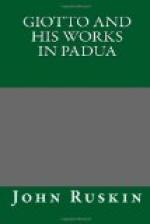[Footnote 9: Lord Lindsay’s evidence on this point (Christian Art, vol. ii. p. 174) seems quite conclusive. It is impossible to overrate the value of the work of Giotto in the Bargello, both for its own intrinsic beauty, and as being executed in this year, which is not only that in which the Divina Commedia opens, but, as I think, the culminating period in the history of the art of the middle ages.]
[Footnote 10: Christian Art, vol. ii. p. 242.]
I may refer the reader to the close of Lord Lindsay’s letter on Giotto,[11] from which I have drawn most of the particulars above stated, for a very beautiful sketch of his character and his art. Of the real rank of that art, in the abstract, I do not feel myself capable of judging accurately, having not seen his finest works (at Assisi and Naples), nor carefully studied even those at Florence. But I may be permitted to point out one or two peculiar characteristics in it which have always struck me forcibly.
[Footnote 11: Christian Art, p. 260.]
In the first place, Giotto never finished highly. He was not, indeed, a loose or sketchy painter, but he was by no means a delicate one. His lines, as the story of the circle would lead us to expect, are always firm, but they are never fine. Even in his smallest tempera pictures the touch is bold and somewhat heavy: in his fresco work the handling is much broader than that of contemporary painters, corresponding somewhat to the character of many of the figures, representing plain, masculine kind of people, and never reaching any thing like the ideal refinement of the conceptions even of Benozzo Gozzoli, far less of Angelico or Francia. For this reason, the character of his painting is better expressed by bold wood-engravings than in general it is likely to be by any other means.




